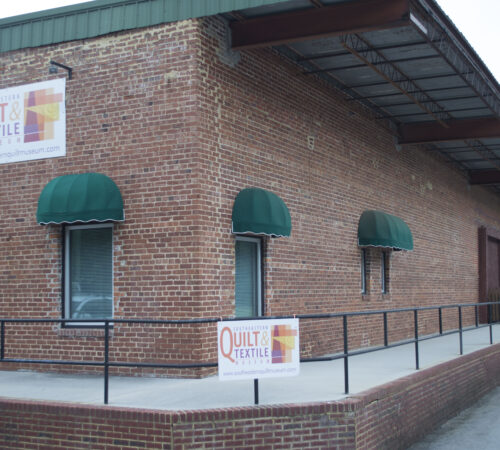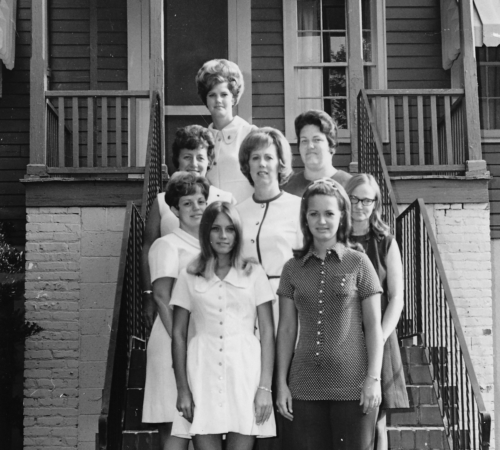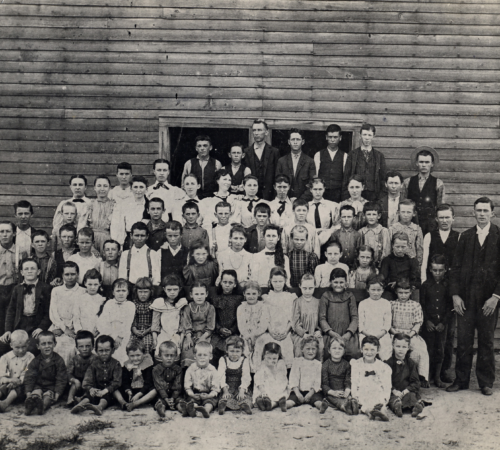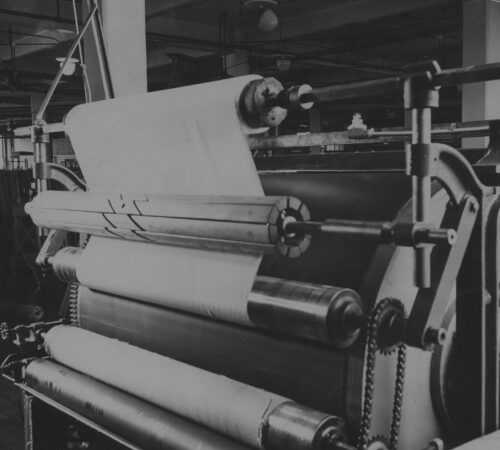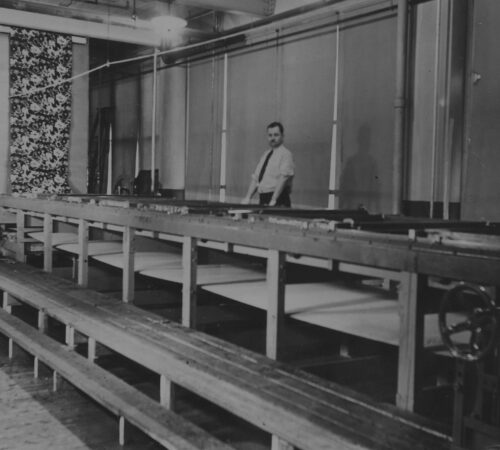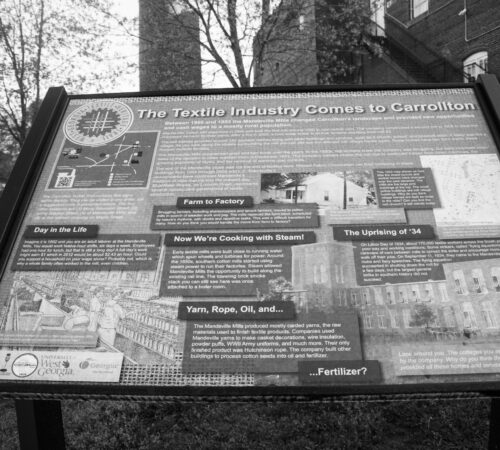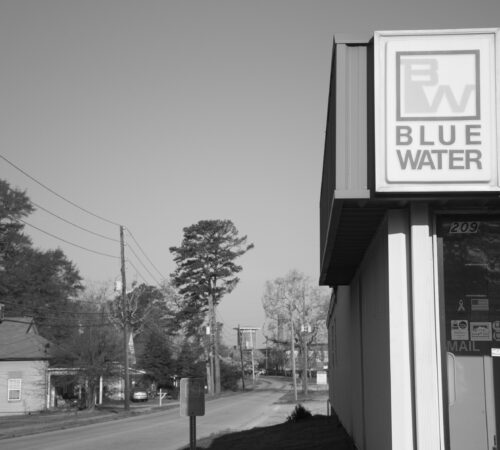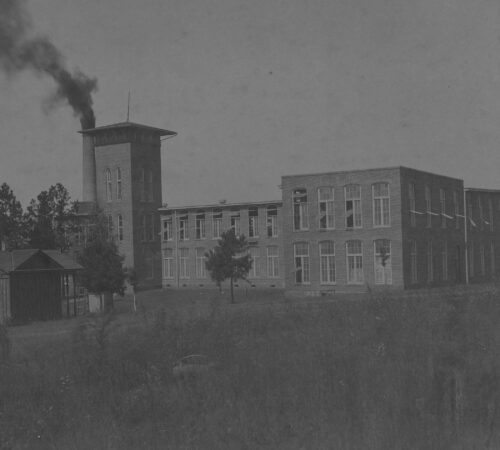Initially home to a lone cotton mill, this community soon saw textile growth through the construction of several hosiery mills.
The textile industry in Carrollton began with the foundation of Mandeville Mills in 1899. This lonely mill produced cotton on its own until the 1920s when numerous hosiery mills began opening throughout Carrollton along Bradley Street, formerly known as Depot Street and the railroad.
Visit
Things to Do
- Southeastern Quilt and Textile Museum, 306 Bradley Street: This museum hosts rotating exhibits on quilts and the textile arts as well as exhibits about the textile industry, including the full story of textile production in Carroll County. Their hours of operation are Thursday and Friday 10:00 am – 4:00 pm and Saturday 10:00 am – 2:00 pm. Look for the Trail’s wayside sign while you’re there!
- Maryon Hosiery Mill, 506 Maple Street: This historic building is now open to the public housing the businesses of Feathers and Twigs, the Fabric Peddler, and the Nest. As these businesses are independently owned, their hours of operation may vary. Look for the Trail’s wayside sign while you’re there!
Places to See
The following properties are not open to the public, but you can view them from the exterior to learn more about the buildings that supported the textile industry here.
- BlueWater Ropes, 209 Lovvorn Road: A Mandeville family business that produces climbing rope, not open to the public.
- Carroll Mill, 202 Bradley Street: This location is now privately owned. This two-story building was the second and final location for the hosiery mill from the late 1920s through the early 2000s.
- Aycock House, 408 Maple Street: This location is now home to a private business. This home was built by one of Mandeville Mills investors and presidents, Joseph Aycock.
- Lawler Lofts, 301 Bradley Street: This location is now home to several businesses and private lofts. This multi-story hosiery mill was built in 1934 and listed on the National Register of Historic Places in 2005.
- Lovvorn House, 701 Maple Street: This location is now a private residence and is not open to the public. This home was built by one of Mandeville Mills investors. Henry Lovvorn.
- Mandeville Home (also known as Maple Street Mansion), 401 Maple Street: This location is now a privately owned business. This home was built by Mandeville Mills founder and first president, Leroy Mandeville, and was renovated as a restaurant, sports bar, and event space throughout the late twentieth century.
- Mandeville Mill and Mill Village, 361 Lovvorn Road: This location is now privately owned and is not open to the public. The mill has been converted to apartments, but visitors can see the range of mill houses that surround the mill as well as an old office building.
History
A growing railroad town, Carrollton became a hub of textile manufacturing in the twentieth century. In 1899, local businessmen established Mandeville Mills, and the mill soon employed over 200 workers to produce cotton yarn and fertilizer and to operate several gins on the property. By 1910, the mill added 120 looms to produce cloth. The company had its own spur lines from the railroad to collect raw product for processing and manufacturing and to ship finished products off to large regional or national markets.
In the 1920s, entrepreneurs began opening hosiery mills along the railroad lines and downtown along Bradley Street, near the railroad depot, and they employed hundreds of women as well as some men. The buildings that once housed Carroll Mills and Lawler Mills are still located downtown; Maryon Mills is on Maple Street, near the Mandeville Mill; and Peds later operated in a building that still survives near Mandeville Mill.
Mandeville Mills closed in 1953, but the grandson of the founder opened a new rope company adjacent to the old mill. His son transformed the plant by the 1980s to create BlueWater Ropes which produces a popular internationally-known synthetic climbing rope. Printed Fabrics opened in the old Mandeville Mill, moving south from Pennsylvania to find cheaper labor. Now the surviving old cotton mill building has been converted into loft apartments, and the mill village still surrounds the historic mill.
Be sure to visit the Southern Quilt and Textile Museum, which is located in a former cotton warehouse on Bradley Street. In the early twentieth century, Carroll County was a booming cotton production center, and warehouses once lined Bradley Street, formerly known as Depot Street.
Charter Trail Members:
- BlueWater Ropes
- Carrollton Area Convention and Visitors Bureau
- Center for Public History
- Carroll County Chamber of Commerce
- Carroll County Historical Society
- Southeastern Quilt and Textile Museum
Resources to Explore:
Click on the following links to learn more about this region.
- Carrollton Spur Walking Tour
- Carroll County Driving Tour
- Facts for Kids
- Digital Library of Georgia
- Georgia Archives Virtual Vault
- Georgia Historical Society
- New Georgia Encyclopedia
Back to Community List
Email the Trail at wgtht@westga.edu or visit our Contact Us page for more information.
